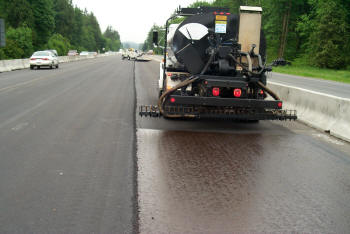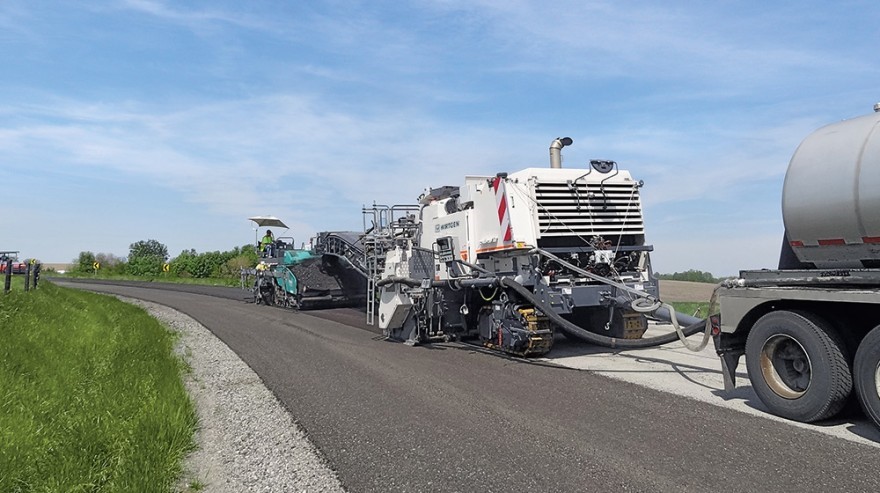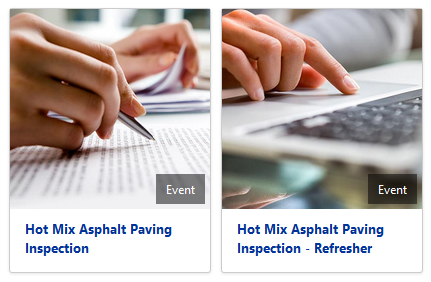
This Executive Update highlights WAPA outreach in our state (Lunch & Learns, Inspection Trainings, Improvement Conference) as well as nationally (Washington Fly-In).
Expanded Options for HMA Inspection Training
Hot Topics Emerge at the Improvement Conference
Taking it to Congress: 2016 Washington Fly-In
Be innovative with available technologies.
Make the best use of your budget and still deliver a better product at the end of the day.
These were the themes heard during the WAPA annual convention last fall, and they continue to be the focus of the many follow-up WAPA Black Bag Lunch & Learn Sessions held in early 2016.
Our Lunch & Learn program enjoyed unprecedented interest this year. We crisscrossed the state this spring, delivering information at nearly 20 sessions. Each Lunch & Learn session includes a core WAPA presentation followed by items that vary based on the interest of the local stakeholders in attendance.
A statewide view
For the first part of each Lunch & Learn, we make sure to cover the following three issues that have immediate relevance across the state of Wisconsin.
- The Combined Bid Specification Changes have been well documented, but it’s still important to outline the basic elements of what we have detailed at the WAPA conference and on our website. In addition to reviewing the rationale for the changes and demonstrating the user-friendly Wisconsin Asphalt Bid/Mix Specification Tool, we take the time to discuss the half dozen most common mixes that a small road agency or pavement owner is likely to use. The simplified system removes much of the subjectivity from mix design and provides more consistency around the state.
- WAPA worked with Wisconsin DOT to boost the state’s requirements for tack coats applied between pavement layers. We’re getting the word out that even for non-WisDOT projects, following the latest tack coat best practices during pavement construction is the way to ensure performance.
- Four Wisconsin pilot projects in 2014 and 2015 demonstrated the performance of pavements built with high reclaimed asphalt pavement and recycled asphalt shingles. Asphalt is already the most recyclable and the most recycled product, and our industry continues to push those levels and be even greener without sacrificing quality.

Our Spring 2016 Lunch & Learn Presentation Slides provide more information on these topics.
Targeting local concerns
Each Lunch & Learn session is tailored to its local audience, and additional presentations are selected based on the interests of local attendees and WAPA members. The topics vary, but three popular sessions this spring are summarized here.
- Warm mix asphalt is starting to become “business as usual” at WisDOT. In fact, for state projects, WisDOT doesn’t differentiate between warm and hot mix—contractors are free to use WMA and often do. Even so, there are still many questions about warm mix among county, city and private road owners.
The WMA Lunch & Learn session outlines the fundamentals and discusses the benefits: improved workability and compaction, reduced energy requirements, lower emissions, and superior performance. Moreover, national research findings from NCHRP indicate that WMA pavements perform as well as or better than HMA pavements.
- There is a national trend to thin lift overlays (or thinlays) as a valuable maintenance tool, and the latest changes to WisDOT’s specifications enable these thinner lift designs constructed with small graded asphalt (4.75 or 9.5 mm). These factors are driving a heightened interest in thin overlays among municipalities in Wisconsin.
Thin overlays can be very effective when implemented for the right pavements (those that have surface deformation but are structurally sound). They are competitive with double chip seals, costing just slightly more but adding significantly to pavement life. They are efficient to build as well. Road users commonly report leaving in the morning driving on a rough road, and driving home the same night over a surface that feels like a brand new road.
- The cold in-place recycling pavement projects at the state level have generated significant interest among locals as well. This was the topic of a 2015 WisDOT workshop (see our April 2015 Executive Update for details). Cold in-place recycling is not only green, but it delivers costs savings for materials as well as energy.
One innovation covered in the Lunch & Learn session is improved cold in-place recycling machinery. New all-in-one units can mill, crush and create new asphalt mix. This reduces the total vehicles required in the recycling train and shrinks the footprint of the operation. This means easier mobilization and the ability to employ cold in-place recycling on smaller projects.

As the Lunch & Learn season winds down and paving work goes into high gear, we remind WAPA members that we are eager to present topics like these and others to you and your local partners. See our Black Bag Lunch & Learn Web Page for more details.
In spring of 2016 WisDOT offered Hot Mix Asphalt Training courses for the third year. The course, taught in partnership with WAPA, continues to serve as an orientation for individuals new to asphalt paving operations or who need a refresher.

In addition to the standard training class, course developers responded to demand for an abbreviated course for veteran specialists and engineers. The half-day short course was offered for the first time in 2016, with sessions offered in each of WisDOT’s five state regions.
“Short-course attendees know the basics” Schwerman explains. “In the abbreviated session we primarily focus on the information that experienced staffers need. That includes current best practices, what’s new or different in the 2016 paving season, and what’s coming for 2017. We also go into a little more depth on technical topics that would be too detailed for an audience of newcomers.”
The evolution of HMA inspection training into two separate courses has proven to be popular and successful. “We have heard from attendees of both courses that the sessions are beneficial and useful,” Schwerman says. “They appreciate that we’re able to give the right information to the right people in the right amount of time.”
See the course outlines for the full-day class and refresher course for more details. Both courses grant professional development credits to attendees. You can learn more about these and other classroom and online training sessions on WisDOT’s Course Catalog Website.
Deb Schwerman also participated in the 2016 ACEC/WisDOT Transportation Improvement Conference held in March in Wisconsin Dells. The event brought together WisDOT and the state’s consulting engineering community for professional development programming and networking opportunities.

WAPA members presenting at this conference included Chris Winiecki of Northeast Asphalt who participated in a contractor roundtable on minimizing impacts to project delivery, and Signe Reichelt of Behnke Materials Engineering who gave a presentation on crumb rubber modified asphalt.
A number of WAPA members were in attendance at the conference as well. Among these member companies, GRAEF was recognized as a finalist for two Engineering Excellence Awards. Congratulations!

The Transportation Development Association of Wisconsin and the Wisconsin Transportation Builders Association cosponsored their 2016 Washington, D.C. Fly-In this April. Members of our state’s transportation industry took this time in our nation’s capital to say thanks to our state’s federal legislators for passing the FAST Act. During this visit we also engaged in dialogue about the pressing next question: meeting the FAST Act’s long-term funding requirements.
Our visit included a small group discussion with Senator Tammy Baldwin. We spoke with her about the impact of the transportation industry and infrastructure on Wisconsin’s citizens and economy. During the course of the fly-in, I also had the chance to outline the importance of the asphalt pavement industry with the offices of House Speaker Paul Ryan as well as Representatives Mark Pocan, Ron Kind, Glenn Grothman, and Sean Duffy.
Beyond Congressional visits, the Fly-In Schedule of Events included an afternoon briefing session with national policy experts. Presentations included updates from the American Petroleum Institute, the American Road & Transportation Builders Association, and the Eno Center for Transportation. The Wisconsin delegation included representatives from industry as well as government, including WisDOT Secretary Mark Gottlieb.
While we will continue to keep in touch with our federal lawmakers year-round here in Wisconsin, the fly-in remains an outstanding opportunity to deliver the message to legislators and their staff members about WAPA: who we are, what we do, and policies that are most important to our industry and to the state.

It has been a very busy spring for us. We tripled our typical number of Lunch & Learn sessions and almost doubled our training sessions.
These efforts have been more than worthwhile, since we were able to connect with so many of our members across the state as well as representatives of state and local government. We have seen and heard firsthand what’s new and what’s important to you, and that helps us to serve you better.
As always, please don’t hesitate to contact us if you have any questions or if there is ever any way we may be of assistance.
Thank you.

Brandon Strand
Wisconsin Asphalt Pavement Association




